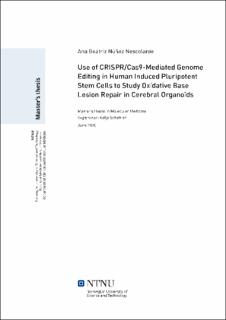Use of CRISPR/Cas9-Mediated Genome Editing in Human Induced Pluripotent Stem Cells to Study Oxidative Base Lesion Repair in Cerebral Organoids
Master thesis
Permanent lenke
https://hdl.handle.net/11250/2670186Utgivelsesdato
2020Metadata
Vis full innførselSamlinger
Sammendrag
The role of DNA glycosylase OGG1 beyond the base excision repair (BER) pathway involves regulation of brain development and function. However, the molecular mechanisms remain to be unravelled. Here, we describe a reliable method to obtain OGG1 deficient human induced pluripotent stem cells (hiPSCs) via CRISPR/Cas9 technology. We observed that electroporation and flow cytometry led to massive death on hiPSCs. However, transient overexpression of BCL-XL and the subsequent treatment with Navitoclax enhanced cell survival and transfection efficacy after electroporation using Human Stem Cell Nucleofactor® Kit 1. Moreover, culture medium supplemented with RevitaCell further improved cell viability after flow cytometry. It was shown that cerebral organoids recapitulate the first trimester of human brain development. Interestingly, OGG1 expression increased as the organoid development progressed. Our results on gene expression pattern from three different stages of cerebral organoid development, were consistent with previous studies, suggesting that organoids are a reliable in vitro model. Taken together, these methods can be applied for the generation of genetically modified cerebral organoids.
